In honor of those who lost their lives in the earthquakes of Sept. 19, 2017 and Sept. 19, 1985, Mexico City—and those who saved lives.
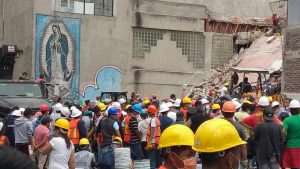 Ten days after the earthquake that shook Mexico City, the official death toll is 358 dead throughout the country, with 217 in Mexico City alone. For reasons that still have not been investigated, the quake killed nearly twice as many women as men. Dozens more are missing, which indicates that the deaths will continue to climb in the coming days. If it’s like in the earthquake of Sept. 19, 1985, some will never be found or accounted for.
Ten days after the earthquake that shook Mexico City, the official death toll is 358 dead throughout the country, with 217 in Mexico City alone. For reasons that still have not been investigated, the quake killed nearly twice as many women as men. Dozens more are missing, which indicates that the deaths will continue to climb in the coming days. If it’s like in the earthquake of Sept. 19, 1985, some will never be found or accounted for.
The numbers are imprecise because another major casualty of this disaster is public information. Families camped outside collapsed buildings are still demanding to know what happened to their loved ones, and the government often cannot or will not provide answers. In the morgues and the disaster sites, the clamor for transparency grows alongside the anguish. Uncertainty generates rumors that quickly fill the vacuum in official information. Social media provides first-hand information and accounts of a city in upheaval but it also feeds the rumor mills.
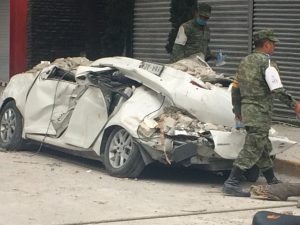 More than 40 buildings have collapsed completely, most containing several stories of offices, shops or apartments. Thousands more sustained serious structural damage with 500 scheduled for demolition. Many families have lost everything. Hundreds of people will be homeless or live in overcrowded conditions with friends or families for weeks or months. The earthquake on September 23, after the powerful quakes of Sept. 7 and 19, revived the terror although it caused little structural damage in the city. The psychological damage will take far longer to repair than the cracks in the walls.
More than 40 buildings have collapsed completely, most containing several stories of offices, shops or apartments. Thousands more sustained serious structural damage with 500 scheduled for demolition. Many families have lost everything. Hundreds of people will be homeless or live in overcrowded conditions with friends or families for weeks or months. The earthquake on September 23, after the powerful quakes of Sept. 7 and 19, revived the terror although it caused little structural damage in the city. The psychological damage will take far longer to repair than the cracks in the walls.
These first days of fall are nothing like other years, when the rainy season ends and students in uniform hurry off to classes. The city has been transfigured. Backhoes scrape the remains of buildings into trucks to haul away as quickly as possible, in the hopes we´ll soon forget what and who was once there. Schools are closed as city architects and engineers struggle to inspect hundreds of buildings for damages and ascertain which are safe to return to. The children are traumatized anyway. Psychologists offer their services for free and send out materials on “How to talk to your child about the earthquake”. In Pushkin Park, clowns amuse kids who’ve come with their families to pick up needed supplies or w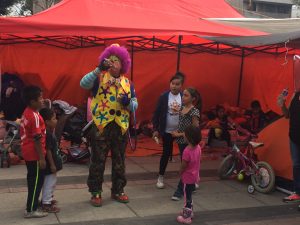 ho are living in the makeshift tents. University students offer coloring books, crayons, paints and other activities to coax a smile out of kids who just lived through hell.
ho are living in the makeshift tents. University students offer coloring books, crayons, paints and other activities to coax a smile out of kids who just lived through hell.
The earthquake struck at 1:14 p.m. We were working on the roof of an old building downtown that began to move, with ominous creaks and rumblings. We grabbed the rails of a fire-escape ladder that swayed wildly and made it down the three floors to the street. There, people cried and hugged each other and waited for the unnatural shaking to stop.
After about half an hour I ducked back in to get my things and headed out to try to find my son, since phone lines and Internet service were mostly dead. In the elegant financial district of Refoma, thousands of people roamed the streets in herds. Unable to return to their workaday world–either because they couldn’t go back into their buildings or because it seemed pointless, or because their adrenalin levels made it unthinkable–they took over the streets that had been abandoned by cars and left to the hordes and the wailing emergency vehicles that attempted to maneuver around them.
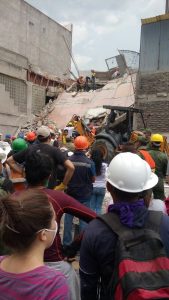 The day marked thirty-two years exactly since the Sept. 19th earthquake that killed anywhere from 5,000 (bodies officially certified) to 30,000, with some estimates going even higher. Only about half of Mexico City, a metropolitan area of 21 million, lived through that earthquake. Most are too young or too recently arrived. You can tell who remembered ‘85; the trauma is stamped in their faces, at the horror of it happening again, on the very same day.
The day marked thirty-two years exactly since the Sept. 19th earthquake that killed anywhere from 5,000 (bodies officially certified) to 30,000, with some estimates going even higher. Only about half of Mexico City, a metropolitan area of 21 million, lived through that earthquake. Most are too young or too recently arrived. You can tell who remembered ‘85; the trauma is stamped in their faces, at the horror of it happening again, on the very same day.
The ‘85 quake registered 8.0 on the Richter scale, compared to this one at 7.1. Because of how the scale works, that’s a much larger difference that it appears. I moved to Mexico City in 1986 and found a city still in ruins. Although then as now the destruction was selective—a building utterly destroyed alongside another seemingly unscathed—the losses were far greater. This time the epicenter was close, just 100 kilometers or so away from this capital city so the smaller quake hit with close to full force.
I walked across town after the earthquake. People hung out in the streets, a steady murmur of ‘where were you when it struck?’, ‘Are you all ok?’, ‘Did you see what happened on the corner of Medellin and San Luis Potosí?’, etc. The destruction ran from floors of buildings pancaked on top of each other to more minor breakage of windows. The spires of an old church had fallen and smashed on the sidewalk. A hospital had cracked windows and a broad scorch mark on the wall from a short circuit; the patients had been hauled out to the sidewalk on stretchers, still in robes. We all waited for aftershocks with the fatalism that Mexico is famous for.
Grassroots Organizing: All for One and One for All
People responded almost instantly. They poured into the streets, first for safety, then for consolation, then to help anyone who needed it. It took no time at all for the deep collective to emerge. Radiating out from the inner circle of family and friends (are they well? Do they need anything?), it began to encompass complete strangers who shared nothing but living together in a disaster zone.
University students took the lead. They formed brigades of rescue workers, therapists, health workers, aid distributors and communicators. They donned hard hats and grabbed picks and shovels and headed to the scenes of wreckage. A popular tweet quoted the stereotype, ‘Millennials are all apathetic and lazy and all they do is sit around watching videos’ then showed a picture of a chain of youth passing supplies to rescue workers.
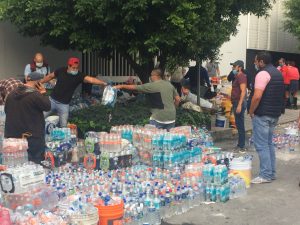 College students and workers, men and women, pulled all-day shifts lifting rubble and loading donations. It began spontaneously, but soon became more and more organized. They create complex systems to sort out donations and register destinations, to coordinate searches, and secure dangerous areas. At Latin America’s largest university, The National Autonomous University of Mexico (UNAM) brigades come and go, holding impromptu workshops so the experienced groups can train the new groups. They pass on knowledge in a quick-learning process that their professors would marvel at, knowledge of things that weren’t on the curriculum. Knowledge of how to save your city.
College students and workers, men and women, pulled all-day shifts lifting rubble and loading donations. It began spontaneously, but soon became more and more organized. They create complex systems to sort out donations and register destinations, to coordinate searches, and secure dangerous areas. At Latin America’s largest university, The National Autonomous University of Mexico (UNAM) brigades come and go, holding impromptu workshops so the experienced groups can train the new groups. They pass on knowledge in a quick-learning process that their professors would marvel at, knowledge of things that weren’t on the curriculum. Knowledge of how to save your city.
Budding sociologists and Spanish Lit majors become de-construction workers overnight. At donation centers set up in public squares and parks and wreckage sites, the volunteers receive whatever the public brings, but send out calls for batteries and bandages. Three boys, obviously from poor families, leave a dolly stacked with cases of bottled water. A car drives by and passes the policeman directing traffic a box of cookies. Neighbors drop off clothing and canned goods. Two young women have started a shelter for the pets of the affected. They hand out flyers offering pet food, kennel services, and veterinary care. All free of charge.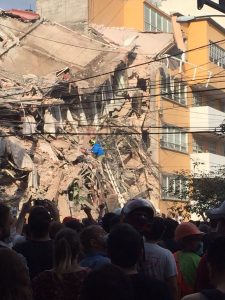
The rules of capitalist society have been thrown out the broken window. Anyone who tries to make money off the tragedy—and there are few—is called out. One message notes that Walmart and Costco are raking in the money of people buying goods to donate without even offering discounts, while the mom-and-pop corner stores that survive on a shoestring have emptied their shelves to donate to the rescue efforts. “Think about who you want to buy from in the future” the writer admonishes.
The commercial media herald the banks’ decision not to charge commissions (Citigroup and other foreign banks charge Mexicans more for services than anywhere else in the world), and free cell phone data from Telmex (owner: Carlos Slim, one of the richest men in the world). But corporate largesse is not what sustains this citizens’ movement. It’s the spontaneous eruption of people helping people, showing a tribal unity that the egotism of consumer society has worked for decades to replace. Neighbors who complained about barking dogs just yesterday lean on each other like long-lost siblings today. Couples open their homes to strangers just because they recognize the need.
The powers-that-be do not like what they see. The government tries to pretend it’s in charge, when even the armed forces are playing a supporting role to the civilian teams in most places. This is a massive civic response not controlled or channeled by the elite and it scares them. At the UNAM students decide to limit the government offices they deliver their donated goods to after reports that they aren’t being taken directly to the needy. The university authorities respond by shutting down the donation center in the stadium. The students keep working on campus in each of their departments. They refuse to go back to classes because the public needs them mobilized, organized and in the streets.
The media conglomerates work overtime to weave a narrative that makes the police and soldiers and politicians the heroes of the rescue efforts and ignores the civil society role. No one believes it because they can see what’s really happening. At site after site, the security forces stand by as the citizen volunteers lead efforts, or worse, they attempt to take control and obstruct urgent tasks. It’s the organized people, like ants that march out of the cracks with an instinctive master plan, who are transforming this city and at the same time, its political culture for years to come.
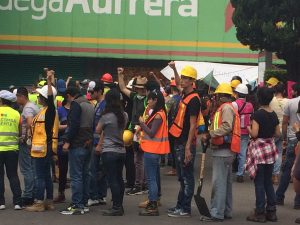 Thousands of people are coming to the aid of strangers with no thought of whether the victims “deserve” it or not, without distinguishing or discriminating, without speeches or fanfare. An entire city in solidarity with itself, brushing off official security forces and sidelining a government desperate to regain legitimacy. The damage, as in ’85, results more from negligence and corruption than from the natural disaster itself. The buildings that fell, it will undoubtedly be established, were built substandard, or were old buildings already damaged and rented out anyway, or housed businesses where occupancy rules were ignored for a wad of bills. Reconstruction will bring its own scandals, of aid money funneled into political campaigns and politicians’ pockets, of international good will squandered by a government seeking to protect its image rather than its citizens. We’ve heard this story before; we know it by heart.
Thousands of people are coming to the aid of strangers with no thought of whether the victims “deserve” it or not, without distinguishing or discriminating, without speeches or fanfare. An entire city in solidarity with itself, brushing off official security forces and sidelining a government desperate to regain legitimacy. The damage, as in ’85, results more from negligence and corruption than from the natural disaster itself. The buildings that fell, it will undoubtedly be established, were built substandard, or were old buildings already damaged and rented out anyway, or housed businesses where occupancy rules were ignored for a wad of bills. Reconstruction will bring its own scandals, of aid money funneled into political campaigns and politicians’ pockets, of international good will squandered by a government seeking to protect its image rather than its citizens. We’ve heard this story before; we know it by heart.
But there’s another story we know by heart—from the same time and in the same place. It’s the story of a society that rose up to save itself, to save a nation. The 1985 Sept. 19th earthquake saw an outpouring of civic solidarity that transformed Mexican political culture. The 2017 Sept. 19th earthquake is having the same effect. Out of the cracks that reveal the corruption and governmental negligence, an almost-forgotten sense of community has arisen that reminds us that even beyond the crisis, we can take care of each other, we can care, we can organize to meet real needs.
And once a society has that knowledge, social change is not only possible, but inevitable.
Photos by Laura Carlsen and Ana Victoria Rodríguez Maroun



